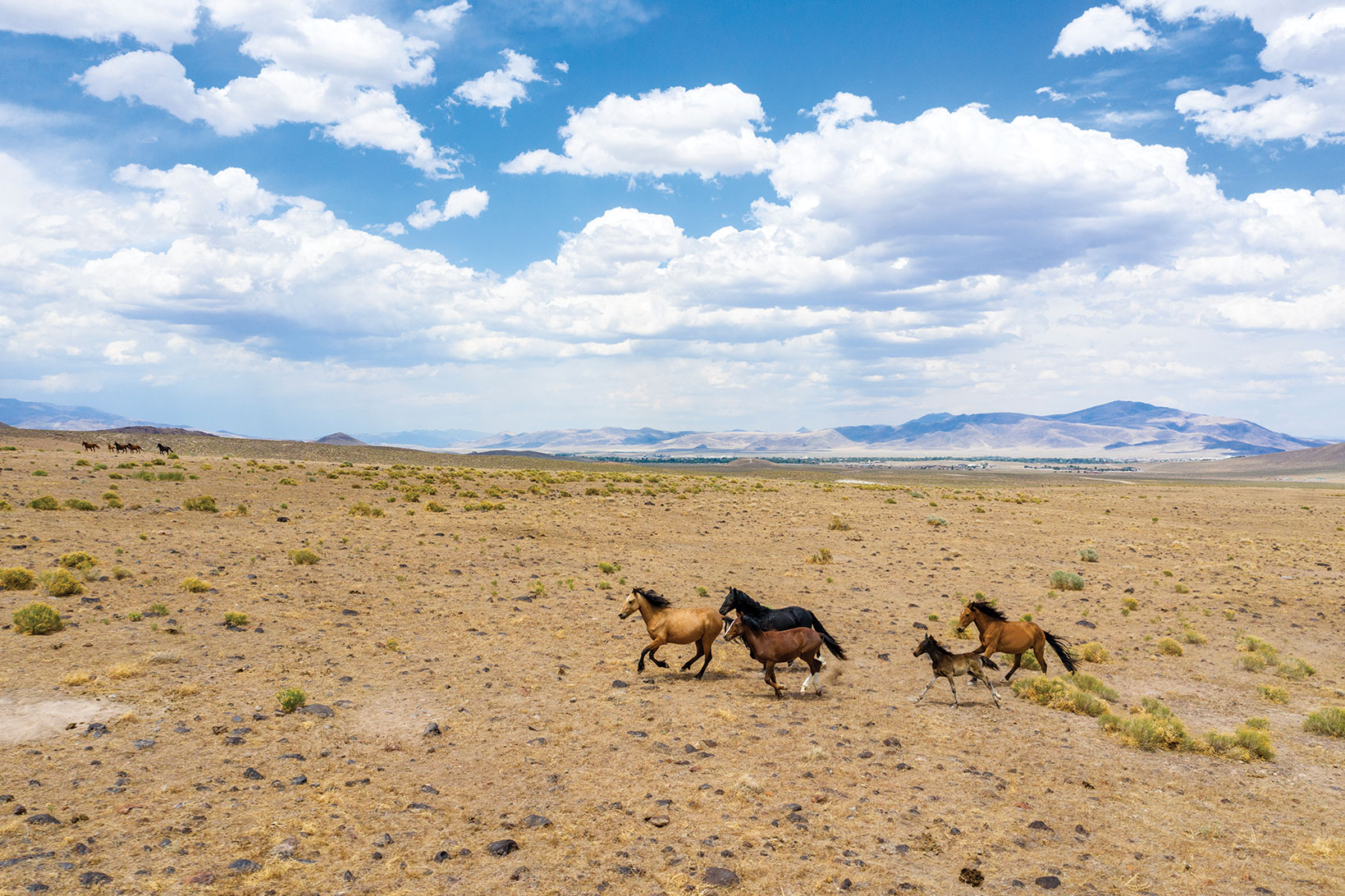
01 Dec Wild Horses: Nevada’s Pride and Burden
These symbols of the West’s wild freedom have overrun portions of the Silver State, leading to controversial and creative herd control
There is a scene in The Misfits, a 1961 film written by the great American playwright Arthur Miller, that encapsulates the complex and emotionally fraught issue surrounding wild horses in the American West.
The film is set in Reno and stars Clark Gable and Marilyn Monroe, both of whom made their final cinematic appearances in the movie. In a pivotal scene, Monroe’s character, Roslyn Tabor, a recent divorcee, is charmed by Gable’s character, Gay Langland, a cowboy who symbolizes the untrammeled freedom of the Old West.
In the scene, Langland tells Tabor that they are rounding up mustangs from a range in Nevada’s sprawling high desert so they can break them and put them to use in an old-fashioned rodeo that celebrates the bygone ways of the West.
But later Monroe’s character discovers the truth—the horses will never be broken by a grizzled vaquero. Instead, they will be delivered to a corral and whisked away to be slaughtered and used in dog food.
The scene lays bare the contradiction at the heart of the wild horse issue. Bands of mustangs are an enduring symbol of the freedom and rugged independence at the heart of the American dream, but those symbols butt up against the cruelties and necessities of the modern world.
As Langland says: “Damn ’em all. They changed it, changed it all around. Smeared it all over with blood. I’m finished with it. It’s like roping a dream now.”
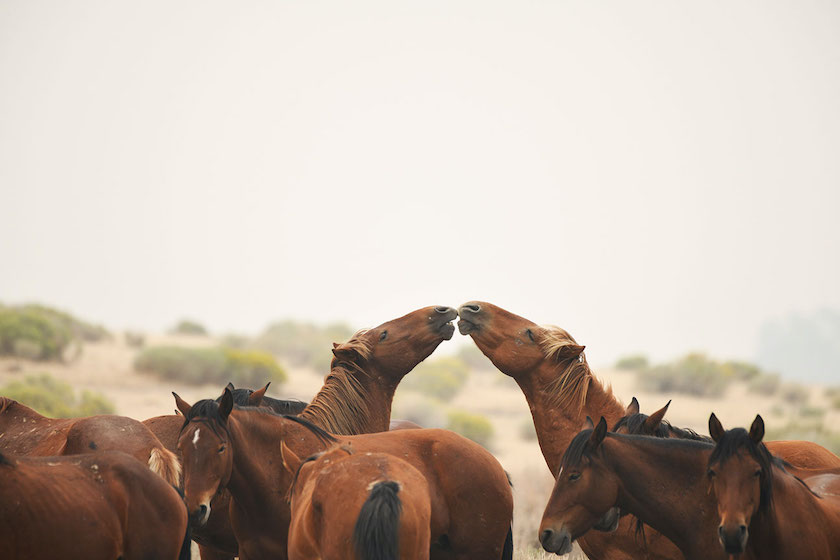
Wild horses in Nevada’s Pine Nut Mountains east of Carson City, photo by Kim Steed
Roping a Dream
It’s no accident that The Misfits takes place in Nevada.
The Silver State is home to more than half of the federally managed wild horses in the United States.
It’s also where Velma Bronn Johnston, known as Wild Horse Annie, was born. In 1950, Johnston was driving to work as a secretary for an insurance company when she saw a horse trailer that was dripping blood onto the road. She followed the truck with the horses to a local slaughterhouse and learned the horses had been gathered from state and private lands in the Virginia Range and would end up as dog food.
She turned her disgust—the same disgust portrayed by Monroe in The Misfits—into a lifetime of activism for the wild horses of Nevada, and, by extension, the entire American West.
Johnston’s fierce, unflagging advocacy culminated in the passage of the Wild Free-Roaming Horses and Burros Act of 1971, which contains the most plainspoken articulation of feral horses’ symbolic meaning for the American West:
“Congress finds and declares that wild free-roaming horses and burros are living symbols of the historic and pioneer spirit of the West; that they contribute to the diversity of life forms within the Nation and enrich the lives of the American people.”
Before the law’s passage, the depredations against the bands of wild horses scattered throughout the West were severe and inhumane. Hunting from airplanes and the poisoning of water holes in the arid portions of the high desert were just a few of the methods by which people rid themselves of the horses or collected them to be sold to slaughterhouses.
“The best protection for the horse is the love of the American people,” says Greg Hendricks, the director of field operations for the American Wild Horse Campaign, a nonprofit that advocates for the humane treatment of horses. “It was the people that demanded the law get passed, whether it was Wild Horse Annie or the school kids who wrote to their Congressman.”
The law, signed by President Richard Nixon, prevented the capture, injury or disturbance of any of the free-roaming horses or burros on federal land.
When Johnston died of lung cancer in 1977 at the age of 65, she likely hoped that her life’s work on behalf of the horses would ensure the contentiousness that sprouted up around the animals was safely laid to rest.
But the battle was just beginning.
While the wild horses of Nevada were vouchsafed the right to roam the lands, new conflicts broke out, principally between horse advocates and ranchers, who complained that the horse populations were exploding, degrading the forage on the range, leaving little for cattle and sheep. That conflict continues unabated to this day.
“There are too many horses in Nevada,” says Doug Busselman, executive vice president of the Nevada Farm Bureau.
This is not one man’s opinion. Scientists, wildlife managers, ranchers and even wild horse advocates, albeit with more reluctance and qualification, agree that Nevada’s wild horse population must be controlled.
The Bureau of Land Management (BLM) estimates that there are currently about 52,000 horses in Nevada, which is about quadruple the agreed-upon carrying capacity of approximately 12,000 equids allotted for the state.
“The damage to public rangelands through chronic wild horse and burro overpopulation is very readily evident in Nevada,” says the agency in a statement prepared for Tahoe Quarterly.
Advocates as well as ranchers also say the population is more than the landscape can sustain.
“We strive to keep the population numbers in balance with the habitat,” Hendricks says, adding that no one wants to see starving horses in poor physical condition.
But that is exactly what JJ Goicoechea is seeing from his ranch in Eureka County, in central Nevada.
“The forage is as bad as I’ve ever seen it,” he says, explaining that drought and an overabundance of horses have deteriorated conditions significantly.
While Goicoechea and Hendricks have traditionally been across the fence from one another on the issue of wild horses, they agree that overpopulation serves no one. They disagree on the sources of overpopulation, however.
Goicoechea chalks it up to decades of federal mismanagement.
“We are talking about 10 to 15 years of not gathering enough horses, not close to enough,” he says.
For Hendricks, the problem is not so much the overabundance of horses as it is a surfeit of cattle and other livestock.
But Busselman and Goicoechea note that a large feral horse population doesn’t just impinge on those running cattle.
The greater sage grouse, currently at the heart of land-use conflicts all over the Great Basin, is utterly dependent on the sagebrush habitat that horses can devour if their bands grow too large.
A 2014 study at Oregon State that focused on a national wildlife area in eastern Oregon, where the sagebrush landscape is nearly identical to much of Nevada, and where cattle are forbidden, found that the horses had a potentially harmful effect on the sage grouse habitat.
Nevertheless, while points of disagreement persist, all those who hold a stake in the issue are essentially in agreement that population numbers as they currently stand are unsustainable.
The real fight in 2020 comes down to what to do about it.
But even in this aspect of the seemingly intractable problem, recent developments have shown an emerging consensus, and even as the nation as a whole seems implacably polarized and unable to reach concordance about the simplest of things, hope for a collaborative approach from ranchers, advocates, scientists and land managers is real.
Some of this hope is predicated upon a small, somewhat odd grouping of horses called the Virginia Range Herd. It is this herd that prompted Wild Horse Annie to begin her advocacy. The Virginia Range is where John Huston elected to shoot The Misfits in 1961 and where the characters of that iconic Western go to wrangle up a few stallions and mares. And it is this range that serves as a location where a pilot project has been established that has a chance to forever alter how wild horses are managed in the American West while establishing a sense of comity among erstwhile antagonists in the agricultural and environmental communities.
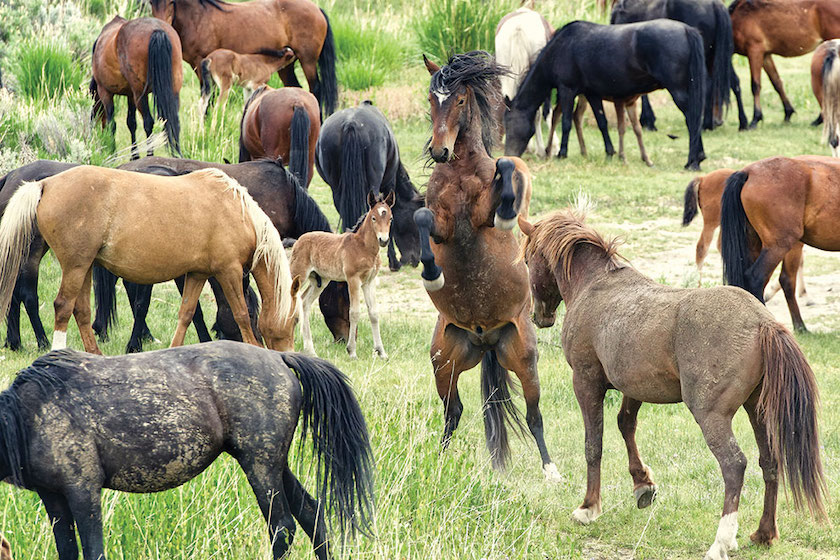
Feral horses, colloquially referred to as wild horses, in the Washoe Valley, photo by Vivian Powers
Wild or Feral?
The aforementioned term “wild horse” is technically incorrect. Biologists distinguish between wild horses, which were never domesticated, and feral horses, which are free-roaming ancestors of domestic horses. There are salient genetic differences between the two.
In the United States, most people colloquially refer to feral horses as wild horses. But mustangs—the appellation for North America’s feral horses—are actually the descendants of colonial Spanish horses brought to the Americas by the conquistadors, beginning in 1493.
Christopher Columbus was the first European to bring horses to the continent, although he brought them along for his second voyage, not his first.
Most of the mustangs in the American West are descendants of horses brought by Hernan Cortes, the bane of the Aztec Empire, who landed in the New World in 1519.
By 1525, Cortes had enough equines for a modestly respectable horse-breeding effort. Toward the end of the same century, Juan de Onate established the first horse-breeding operation in what is now the United States, when he grew his initial 75-horse herd to more than 800 in a settlement that would become Santa Fe, New Mexico.
Native Americans, most notably the Apache and Navajo, quickly adapted to the introduction of the horse, using them as transportation and as a crucial means of hunting. By the 1700s, nearly all the Plains Indians had horses. The Nez Perce people, indigenous to the Pacific Northwest, became so adept at breeding horses, they developed one of the first distinctly American horse breeds—the Appaloosa.
In the nineteenth century, due to war, displacement or ill luck, settlers and native tribes turned their horses loose on the range, establishing the first instances of free-roaming horses in the United States. Ulysses S. Grant, in his memoirs, recalled seeing a huge herd during his visit to an area between the Nueces River and the Rio Grande in Texas in 1848.
“There was no estimating the number of animals in it; I have no idea that they could all have been corralled in the state of Rhode Island, or Delaware, at one time,” he wrote.
From there, the equine population exploded in the West. Horses are particularly adept at reproducing, capable of expanding their herd by 20 percent every year, meaning their population can double in four or five years.
The mustang probably peaked right before World War I, when they were requisitioned for use in the United States cavalry. As more settlers poured into the West, ranchers impinged on their territory, erecting fences and taming the untrammeled wilderness while squeezing the bands of horses into ever-tighter spaces.
By the middle of the twentieth century, the so-called mustangers, who made a living capturing wild horses and gentling them for use, were left roping the dream. The West had been largely divested of its wild, and the arguments about the future of free-roaming horses intensified.
“Free-roaming” is yet another technical word. The wild horse actually refers to the only two species that were never domesticated—the tarpan, or Eurasian wild horse, and Przewalski’s horse, or the Mongolian wild horse. The tarpan has since gone extinct, and the Mongolian wild horse is endangered but rebounding.
The mustang and other such horses that have domesticated ancestors but now roam free—such as the brumbies in Australia or the Sorraia in Portugal—are known to biologists as feral horses.
While the distinction is taxonomically important, belly up to a bar in Reno and use the term feral horses to describe the bands that stalk the range and you might get looked at askance.
Most of the advocacy organizations use the colloquial rather than the technical term.
There is an undeniable irony at the heart of this wild-versus-feral horse distinction that has caused, like many aspects of the wild horse issue, divergent perspectives and fierce debate.
While mustangs are not wild horses, per se, wild horses did originate in North America, as fossil records demonstrate, but migrated to Asia and Europe via the Bering Strait in Alaska—using the same land bridge that allowed humans to fan out across the continents.
Horses were extirpated (when a species becomes extinct in a certain area but still maintains populations elsewhere) from North America during the Quaternary extinction event, which led to the disappearance of prehistoric animal species such as the woolly mammoth and saber-toothed cat.
The North American origin of wild horses has led many advocates of the current free-roaming equines to argue that these creatures should not be regarded as invasive, but instead as returning to the vital ecological role they formerly vacated.
This is not the position of all wildlife advocates, however.
“Feral horses and burros are invasive species in North America,” the Wildlife Society, an international wildlife advocacy organization, stated in 2011. “Where feral horse and burro density is high, lands are degraded, water resources are limited, and native species are already stressed, impacts can be substantial.”
Many advocates assert the horse’s significance extends beyond the biological or ecological into the arena of cultural significance.
Shannon Windle, of the Hidden Valley Horse Protection Fund, says the horses are an iconic emblem and can be used to enhance ecotourism around Reno and Carson City.
“They represent for us an era that is long gone,” she says. “They represent the freedom to roam. It’s a joy to behold their spirit, their beauty.”
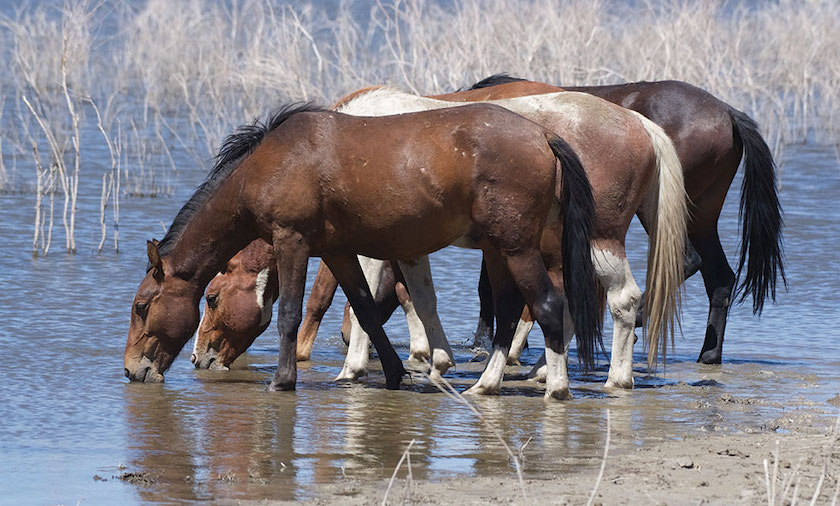
Thanks to Wild Horse Annie, the Virginia Range Herd is perhaps the most famous herd in the American West, photo by Kim Steed
Home on the Virginia Range
Taxonomic complexities and technical appellations compose a mere slice of the overall confusion, which is compounded by differences in management driven by whether the land where the horses roam is private or owned by the county, state or federal government.
The Virginia Range Herd occupies roughly 300,000 acres, with Carson City at the southern reach and Fernley and Reno carving the northern perimeter. It’s a patchwork of private and state lands and is one of the only places in Nevada, which is 85 percent federally managed land, where horses roam without federal management.
There is an irony that the Virginia Range is carved out from the very federal protections advocted by Wild Horse Annie.
“They don’t have those protections,” Hendricks says. “We are their hope.”
In many ways, the horses of the Virginia Range are similar to horses scattered throughout the West. While they occupy a place that is not home to much ranching or agriculture, they are in constant conflict with humans.
They infiltrate gardens in the Damonte Ranch area of Reno, they gallop through neighborhoods, sometimes finding themselves on busy roads and highways with the potential to cause serious accidents.
“We started getting more and more horses moving into the area,” Windle says. “In the winter of 2008-09, there were 18 horses hit and killed in the Damonte Ranch area alone.”
Windle says it was because private property developers were removing fencing and behaving irresponsibly.
Busselman, of the Farm Bureau, says it’s because there are too many horses on the range.
“We just can’t get to the appropriate management level,” he says.
It’s particularly frustrating for Busselman, who points out that, according to Nevada state law, the horses on the Virginia range are not technically wild or feral, but instead categorized as estray livestock. In other words, the horses are considered in legal terms to be no different than cattle or sheep that escaped their pen, which frees up the state to treat the animals as such.
But Nevada is well-apprised of the ferocious protectiveness that many individuals and groups feel for the horses—and is at pains to point out that no horses have been euthanized since 2013.
Nevertheless, the state is concerned about the population numbers. The last count taken in January 2018 showed approximately 2,900 horses on the range. The Nevada Department of Agriculture says the range can support about 600 horses at most, with about 300 individuals representing the ideal amount.
“A challenge we face is managing an increasing population of horses,” says Jennifer Ott, the director of Nevada’s agriculture department.
The state says it’s building fences along its highways to try to curb car accidents, as the Nevada Department of Transportation (NDOT) reported 240 horse-related crashes between 2017 and 2019, with 45 resulting in human injury and one death. As a result, NDOT has installed wildlife fencing along sections of U.S. 50 and other area highways, including 14 miles between Stagecoach and USA Parkway.
“We have an ongoing collaboration with NDOT to track and identify stretches of highway that may be a candidate for additional infrastructure,” Ott says.
USA Parkway has experienced massive growth recently and may be poised for more. Google built a data center in that area, a stone’s throw from Tesla’s Gigafactory and nearby Switch Citadel data center campus. The area also houses a Walmart distribution center and Blockchains LLC, all of which displays an increasing economic might in northwestern Nevada that, while beneficial to some, could bode ill for the horses of the Virginia Range.
“Some big developments have gone in and it’s really squeezing their habitat,” Hendricks says.
The American Wild Horse Campaign also points out that the well-heeled property owners surrounding USA Parkway make it difficult for scientists to access the range, and thus to know how much forage is available in the area.
It’s not solely the Virginia Range, where attempts to get an accurate picture of the forage are difficult, Hendricks says. He points to a 2013 report by the National Academy of Sciences that analyzed the Bureau of Land Management’s entire free-roaming horse and burro program and found that there was little scientific basis for how the agency arrived at carrying capacity numbers (how many horses the range can sustain).
“The committee could not identify a science-based rationale used by BLM to allocate forage and habitat resources to various uses within the constraints of protecting rangeland health and listed species,” the report states.
BLM uses a concept it calls Appropriate Management Levels, or AMLs, which attempts to convey the number of horses the landscape can sustain in a given management area given the amount of forage available along with livestock operators and other wildlife.
Hendricks says the BLM isn’t transparent with its AML levels largely because it wants to keep horse population numbers unnaturally low to please livestock interests.
“The BLM has allotted about 27 million acres for wild horses, but 145 million acres are dedicated for grazing allotments, and a lot of those overlap,” Hendricks says. “Eighty percent of the forage is allocated to cows.”
He says all his organization asks is that the horse gets a “fair shake.”
The BLM contests a lack of transparency, saying it allows public comment during the periods where it attempts to establish the AMLs.
“The BLM establishes AML after an evaluation of rangeland resource and population data spanning several years, including data relating to vegetation and soil types, weather and water quality,” the agency says.

Wild horses are commonly seen in the Damonte Ranch area of south Reno, where the local high school’s mascot is appropriately the Mustangs, photo by Peter Day
From Freedom to the Slaughterhouse
Deb Walker, who also works for the American Wild Horse Campaign, agrees with Hendricks that federal and state agencies are being coy with certain aspects of their program.
Walker says there is currently no way for interested parties to track the horses that are adopted out by the BLM to ensure they are being treated properly.
Since 1971, the BLM has pledged to gather excess horses and burros from public lands and then put them up for adoption so the horses can find good homes. While the program is well-intentioned, both ranchers and horse advocates question whether it is working.
About 2,500 horses are adopted each year, which is well short of how many animals are removed from the range. In May 2020, the BLM proposed removing approximately 18,000 to 20,000 animals per year, meaning only about 15 percent of the horses gathered will be adopted.
The BLM projects it can adopt out 7,000 horses per year due to public-private partnerships, but critics think such projections are rosy. The horses that are not adopted are often kept in short-term holding pens at enormous expense to the American taxpayer.
“The BLM has frittered a lot of money away,” says Goicoechea.
In 2016, the Department of Interior’s Office of Inspector General said the BLM was failing to maximize the use of long-term pastures for excess horses and over-relying on short-term facilities.
“BLM could save costs if it transports horses from higher-priced short-term corral facilities to long-term pastures with vacancies,” the report states.
There are about 50,000 horses in short-term holding facilities across the West, according to the latest estimates.
The agency says it is attempting to shift its focus to long-term holding facilities aimed at conserving taxpayer resources.
“Recently the agency announced the awarding of contracts of seven new off-range pastures with a combined capacity of 5,000 head to support this goal,” the BLM says.
Walker says that government waste is only part of the problem.
“I am concerned about the amount of BLM horses that end up in kill pens,” Walker says.
The BLM has looser restrictions around adopting out horses that have been put up for adoption three times and failed, or if they are older than 10 years old. This has created an opportunity for unscrupulous investors to find loopholes to take advantage of the adoption program.
The most notorious case involved a rancher named Tom Davis, from La Jara, Colorado, who adopted approximately 1,700 horses between 2008 and 2012 from the BLM, all the while attesting he was affording the horses a good home. He was instead selling them to slaughterhouses in Mexico.
Walker says the case highlights the BLM’s lack of transparency regarding where adopted horses end up.
Often people will adopt horses to receive a $500 stipend from the BLM, wait a year to receive the second installment, and then make some additional money by selling the horses to Mexico, where they are slaughtered for their meat.
“It’s a dark and dirty industry,” Walker says. “It’s also very difficult to track, so we are likely only seeing a tiny proportion of it.”
Walker wants the agency to follow up to ensure the horse adoptions are conforming to regulations and would like to see more records kept that are subject to Freedom of Information Act requests from the public.
The BLM says it maintains a law enforcement arm that investigates certain cases while retaining jurisdiction, and that the agency will occasionally repossess horses without a proper title that end up in “sale barns,” but mostly its hands are tied after the animals are adopted out.
“BLM does not have the means or legal authority to direct or track the disposition of animals once they pass into private ownership,” the agency says.
While some argue the overpopulation problem should lead the federal government to consider euthanization as a tool, recent polls show little public appetite for killing wild horses. A poll conducted by the Public Policy Polling in 2017 showed that 74 percent of respondents wanted Congress to continue the ban on slaughtering horses.
“Americans regard the horse differently than other countries,” Hendricks says. “They are a spiritual animal for us. Also, the horse did a lot for humans; they helped us get out West and settle this country.”
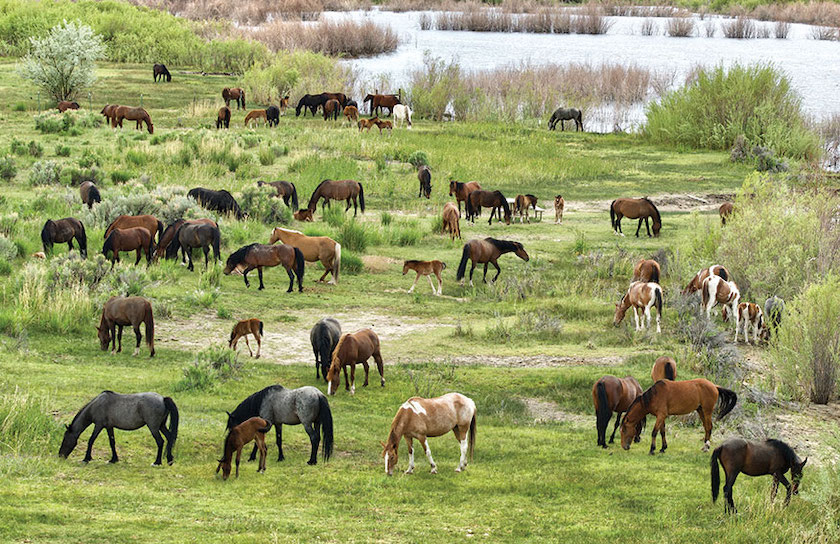
The high density of wild horses in Nevada has led to conflicts among horse advocates and those who believe the animals are degrading the land, photo by Vivian Powers
Health of the Rangeland
Goicoechea says his family helped settle the Newark Valley in eastern Nevada. He is a descendent of Basque herders who emigrated from Spain and have worked the sagebrush landscape around Elko for four generations.
He knows his range intimately because his livelihood depends on it.
While some of his rancher neighbors scorn words like sustainability, suspicious of what they view as its New World Order connotations, Goicoechea says he knows it just describes the principles he and his fellow ranchers have been applying for generations.
“We are the ones who make sure the water is running, the fences are up and the rangeland health is in good condition,” he says. “If I let my cows eat too much of the forage, I am the one who will suffer the consequences the following spring.”
He says the range needs to be carefully managed by all who use it, including wildlife managers, ranchers and recreators.
Goicoechea differs from some of his neighbors, too, in that he is willing to work with those on the opposite side of the wild horse issue to arrive at solutions.
“Horses have a right to be there,” he says. “But they have to be managed. If they are not managed properly, then everybody loses.”
Right now, part of the problem is money. BLM’s present method of gathering horses is to use helicopters to drive entire bands of horses to corrals, where they are branded and processed with an eye toward adoption or being turned out to pasture at the agency’s long-term holding facilities.
Goicoechea is skeptical of the method.
“We’re just training them to run to the trees,” he says. “Around here, when a horse hears a helicopter, they just head straight for the timbered areas of the mountains. They are smart animals.”
The rancher further believes the BLM doesn’t have the funding to gather horses frequently enough, which is one of the main reasons the horse population is overabundant throughout Nevada.
“Congress was slow to react and was not funding the BLM with what they needed,” he says.
The BLM acknowledges managing horse populations will be costly in coming years, but says the cost of doing nothing will be worse.
“The BLM’s preliminary estimates show costs could reach several billion dollars over multiple years for actions such as reducing overpopulated herds,” the BLM says. “The cost of doing nothing is the continued rapid growth in overpopulated herds, further degradation of our public rangelands, and a rising risk of starvation and thirst for wild horses and burros.”
While Goicoechea and Hendricks have been embittered combatants in the past, both men advocate a similar solution, and the key can be found where this story all started—the Virginia Range Herd.
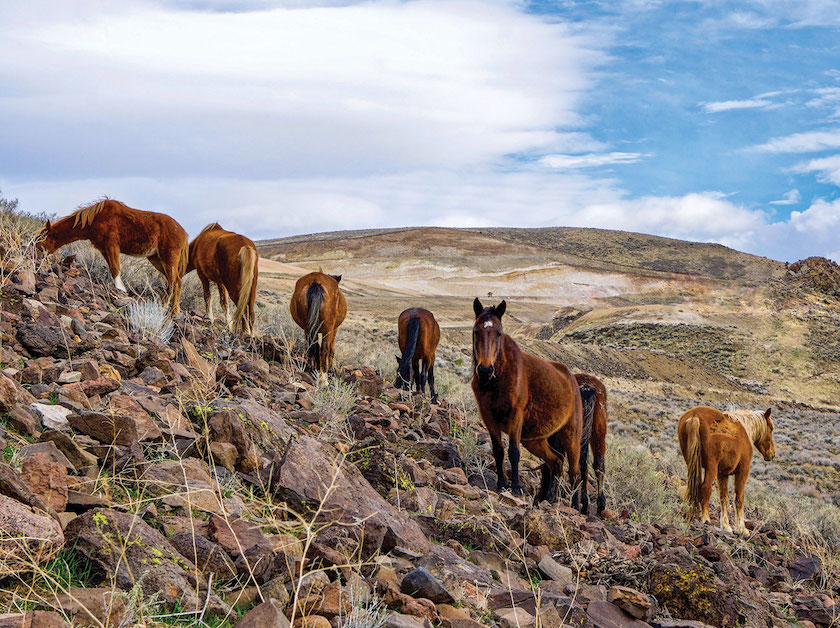
Feral horses forage on a rocky hillside east of Sparks, photo by Christine Virdee
Proof of Concept
Since April 2019, the American Wild Horse Campaign has contracted with the Nevada Department of Agriculture to implement a fertility control program on the Virginia Range horses.
The nonprofit uses a team of volunteers wielding dart guns capable of injecting the horses with Porcine Zona Pellucida (PZP), an extraction of pig ovaries capable of causing infertility in wild horses and burros. The program has a chance to revolutionize how wild horse populations are controlled on the range.
“It’s the largest fertility control program in the world,” Hendricks says.
In the first year of the program, the campaign enlisted 22 volunteers to shoot dart guns to treat 958 mares with PZP, all at a cost of roughly $180,000, according to Deb Walker.
“There are no adverse effects. The PZP doesn’t get into the environment,” she says. “This is the best way to keep horses in their habitat while reducing their numbers.”
Goicoechea says the program has promise and believes ranchers would be willing to help administer infertility drugs to horses in their respective management areas.
“Ranchers would most certainly partner,” he says. “I know a lot of ranchers would.”
Busselman is not convinced.
“Listen, you have to do the second treatment for it to be effective,” he says. “I know it makes volunteers happy to feel like they are doing something, but you are trying to drain the ocean with a spoon.”
For instance, the Virginia Range horses would have to reduce their levels by 2,200 horses to get to a manageable carrying capacity, Busselman says.
Both Busselman and Goicoechea also say the Virginia Range herd is a poor proxy for the herds that span Nevada, given that they are a little tamer and accustomed to human interaction, which makes them easier to dart.
Walker says that is nonsense.
“The Virginia Range has varied conditions, varied terrain and the horses are often difficult to find, and we are still being successful,” she says.
Goicoechea says in order for fertility control to be effective, horse populations need to be reduced to manageable levels.
“That’s why the humane society and the cattlemen are sitting down at the same table,” he says. “Things are starting to change in Nevada.”
It’s this spirit of cooperation that fosters hope in all the parties, with even Busselman acknowledging cause for guarded optimism.
“I remain optimistic. I’m not going to walk around hopeless,” he says. “But we have a huge hill to climb.”
For now, the Virginia Range herd represents the foot of that hill. If the fertility program is successful there, look for it to spread across the American West.
Hendricks says it’s fitting those horses should play such a pivotal role in the future of wild horse management.
“When Wild Horse Annie proposed her bill to Congress, these were the horses she was focused on,” he says. “These were her horses.”
Providing a way to sustainably manage them isn’t just important from a biological or economic perspective, he asserts. It’s about preserving something symbolic about this nation’s once-wild frontier, something that lives still.
“We who live in the West can relate to their independence and freedom,” he says. “These horses are tenacious, they are survivors. These are American characteristics that are displayed by these horses that live free on the range.”
Matthew Renda is Santa Cruz-based writer and former Tahoe resident who has long been intrigued by the wild horses of the American West.




Steven Rose
Posted at 10:02h, 27 JanuaryMatthew–You all really need to read the book Wild Horse Annie and the Last of the Mustangs so you know more about your subject. In the year 1900 there were 2,000,000 wild horses in the U.S. and now there are about 125,000 after the BLM had allowed them to be poisoned, shot, run to death and did the bidding for the cattle industry. there are now about 50,000 in BLM pens being held for life at a cost of $100,000,000 yearly to American taxpayers. Ridiculous, wasteful and inhumane. SR/Vietnam Veteran
Nj
Posted at 10:39h, 08 MayThis is an eye opening article and after reading the comment from the vietnam vet, my heart is broken. These animals need to be left alone.
Monica
Posted at 14:18h, 18 JuneMany animals depend on horse manure to help maintain soil moisture to prevent brush fires.
In cold climates, many animals will follow the path of horses in order to find access to food and water. The powerful hooves of a horse have the ability to break through ice, making streams once again potable for other animals. Furthermore, horses can make their way to grasses through deep snow, allowing other animals to also graze where horses have been.
Grazing cattle, on the other hand, pose a threat to 14 percent of endangered animal species and 33 percent of plant species as they encroach further into their territory.
There are not as many wild horses as BLM claims. Thats a excuse to do roundups. Round ups actually increase population of the wild horses. The virginia range fertility program works. Its cost effective and does not harm the horses. The BLM should not be allowed to manage the wild horse program any longer.
Debbie Dunn
Posted at 13:49h, 03 SeptemberThe fact that greed is running the show when it comes to mustangs, is absolutely atrocious! Big oil, cattlemen and ranchers will never leave those poor horses alone. Not until they get all the land. That is why they need to be stopped now. The BLM is their puppet. We need to get the President and Congress to stop it and make hauling horses to Mexico and Canada illegal. They need to release horses that aren’t adoptable. The holding pens are a joke. Tablature doct want to pay that and they don’t want the horses penned up forever. Simple solution… Don’t round them up. They old and the weak horses will pass naturally. They don’t need human intervention.
W Bachman
Posted at 00:22h, 18 SeptemberFeral horses and burros-like domestic cattle and sheep- are Eurasian livestock, now numbering in the millions throughout the entire world. They compete with much scarcer native North American deer and Bighorn Sheep, and degrade the micro environments that the lives of increasingly endangered North American native plants, arthropods, fish, amphibians, reptiles, birds and other mammals depend on. Advocating the unrestricted free roaming of feral horses and burros (as well as domestic cattle and sheep), without any concern for native plants and wildlife, ironically just becomes the latest chapter in our long reckless history of replacing original North America through Eurocentric cultural values..
Kim
Posted at 18:44h, 01 OctoberLies… Some of those pictures are actually horses that live on ranches out west They tried to make you think that they are all beautiful and running free when they actually belong to someone that’s taking care of them. They want you to believe that all these wild horses look like this healthy shiny beautiful tails and names when it’s actually someone taking care of them so they don’t want to show you the real pictures.. the real truth is the animals are skinny and starving with matted tails and manes missing teeth missing eyes full of scars horses that are starving to death